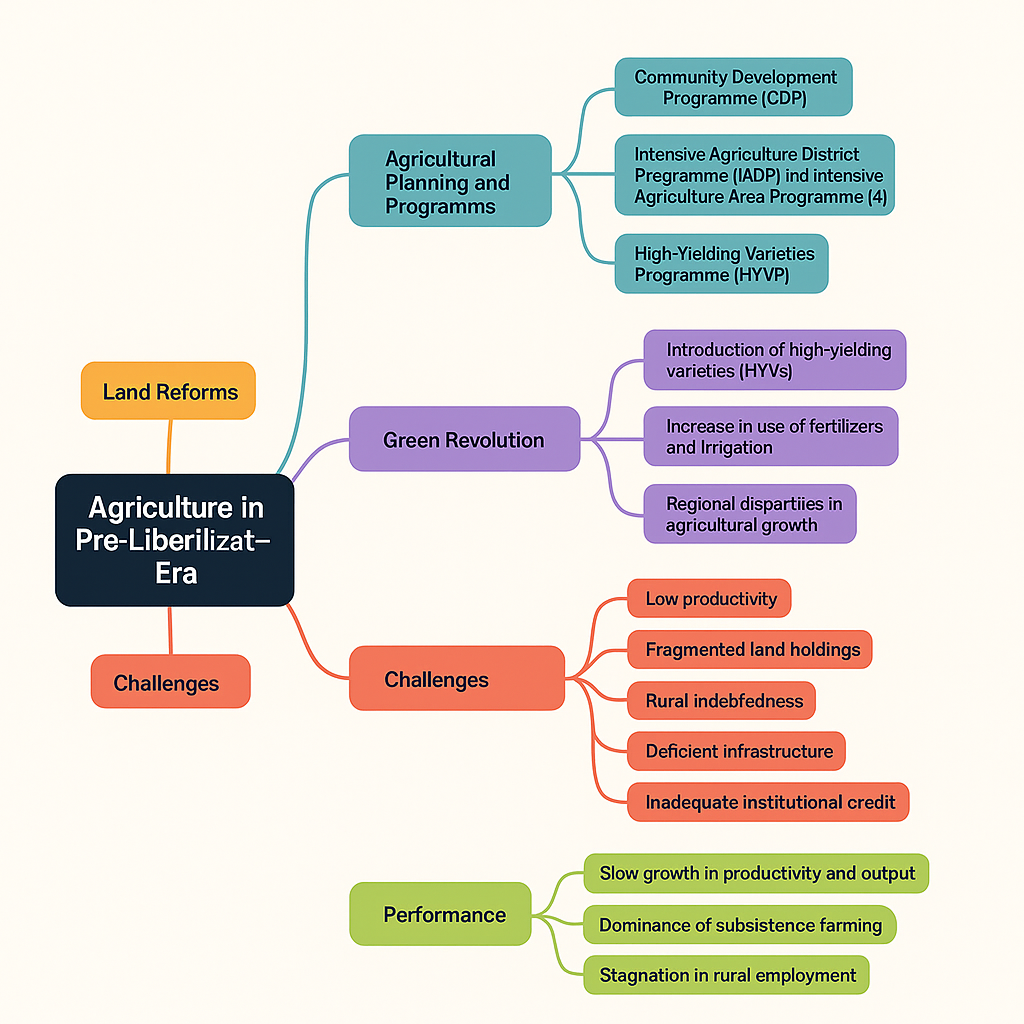
31 Jul Agriculture in Pre-Liberalization Era
Agriculture in Pre-Liberalization Era
The period from 1947 to 1991 marks the pre-liberalization era of Indian agriculture. During this time, agriculture remained a crucial sector of the Indian economy, employing over 70% of the population and contributing significantly to GDP. However, it faced numerous structural problems such as low productivity, land fragmentation, and subsistence farming. Various state-led initiatives attempted to reform and modernize the agricultural sector through land reforms, institutional support, technological inputs, and rural development programs.
Mind Map: Agriculture in Pre-Liberalization Era
1. Importance of Agriculture in Post-Independence India
- Primary source of livelihood for rural population
- Supplier of raw materials for industry
- Key driver of food security and employment
- Important contributor to foreign exchange through exports
2. Structural Features of Indian Agriculture (1947–1991)
- Dominance of small and marginal farmers
- Rain-fed and monsoon-dependent agriculture
- Widespread use of traditional techniques and tools
- Fragmented landholdings due to inheritance laws
3. Land Reforms
Land reforms were seen as a cornerstone for rural transformation and social justice.
3.1 Objectives
- Eliminate intermediaries (zamindars)
- Provide security of tenure to tenants
- Impose ceilings on land holdings
- Redistribute surplus land to landless farmers
3.2 Outcomes
- Legally abolished zamindari system, but loopholes remained
- Fragmentation and concealed tenancy persisted
- Ceiling laws implemented variably across states
4. Agricultural Planning and Key Programs
Post-independence agricultural policy was driven through various rural development programs.
- Community Development Programme (1952): First effort at integrated rural development
- Intensive Agriculture District Programme (IADP) – 1960s: Emphasized increased yield through modern inputs in selected districts
- Intensive Agriculture Area Programme (IAAP): Wider coverage based on IADP experience
- High Yielding Varieties Programme (HYVP): Paved the way for the Green Revolution
5. Green Revolution (1965–1985)
The most significant agricultural transformation in the pre-liberalization period was the Green Revolution led by M.S. Swaminathan and supported by global institutions like the Ford and Rockefeller Foundations.
5.1 Key Components
- Introduction of High-Yielding Varieties (HYVs) of wheat and rice
- Use of chemical fertilizers and pesticides
- Expansion of irrigation facilities
- Mechanization and credit support
5.2 Impacts
- India became self-sufficient in food grains
- Significant increase in wheat and rice productivity
- Led to regional inequality – Punjab, Haryana, Western UP benefited the most
- Neglected pulses, coarse cereals, and eastern India
- Environmental degradation due to excessive input use
6. Institutional Support and Rural Credit
- Establishment of NABARD in 1982
- Expansion of cooperative banks and rural branches of commercial banks post-nationalization (1969)
- Integrated Rural Development Programme (IRDP) for rural poor
- Food Corporation of India (FCI) created in 1965 to manage procurement and public distribution
7. Agricultural Price Policy and Food Security
- Minimum Support Prices (MSPs) announced to protect farmers’ interests
- Public Distribution System (PDS) evolved to manage food supply and price stability
- Buffer stock maintenance by FCI helped during droughts and food shortages
8. Challenges in Agriculture
- Low productivity and yield gaps
- Dependence on monsoon and lack of irrigation
- Fragmented and small landholdings
- Rural indebtedness and poverty
- Deficient market access and post-harvest infrastructure
- Inadequate credit and insurance facilities
9. Performance Overview (1947–1991)
- Food grain production increased from 50 million tonnes (1950-51) to 176 million tonnes (1990-91)
- Agriculture’s share in GDP declined from over 50% to about 30%, indicating diversification
- Employment in agriculture remained stagnant, suggesting limited shift to non-farm sectors
Infographic: Agriculture in Pre-Liberalization India
10. Regional Disparities in Agricultural Growth
- Green Revolution mainly benefited northwestern India
- Eastern, central, and southern regions remained behind in productivity and income
- Dryland agriculture in Deccan Plateau continued facing frequent droughts and low output
11. Environmental Concerns
- Overuse of groundwater for irrigation
- Soil degradation due to fertilizers and monoculture
- Decline in agro-biodiversity
- Neglected traditional organic farming practices
12. Conclusion
Agriculture in the pre-liberalization era was a mixed story of achievement and challenge. While India managed to escape the “ship-to-mouth” food crisis and achieved food self-sufficiency, the sector remained plagued by structural weaknesses and rural poverty. The foundation laid in this period, however, enabled future reforms and modernization post-1991. A holistic approach involving technology, institutional support, and sustainability remains essential even today.
Best economics optional coaching for upsc
Best economics optional teacher for upsc
best economics optional test series
Previous Year UPSC Questions (Mains)
- Examine the contribution of Green Revolution to food security in India. (2021)
- Discuss the major land reform measures adopted in India after independence. Why did many of them fail? (2018)
- Evaluate the role of institutional credit in agricultural development before liberalization. (2015)
Probable UPSC Mains Questions
- Critically evaluate the impact of pre-liberalization agricultural policies on rural inequality.
- What were the key features of India’s agricultural price policy in the pre-reform era?
- To what extent did the Green Revolution alter the structure of Indian agriculture?
Probable UPSC Prelims Questions
- Which program marked the beginning of intensive agriculture planning in India?
- Who is known as the father of the Green Revolution in India?
- NABARD was established for which of the following purposes?




No Comments